
HOME
INTRO
SYMBOLS
ALMANAC
ECONOMY
GEOGRAPHY
STATE MAPS
PEOPLE
FORUM
NEWS
COOL SCHOOLS
STATE QUIZ
STATE LINKS
BOOK STORE
MARKETPLACE
GUESTBOOK
CONTACT US


You may double left-click on a word on this page to retrieve its definition. Tweet Follow
Maryland State Tree
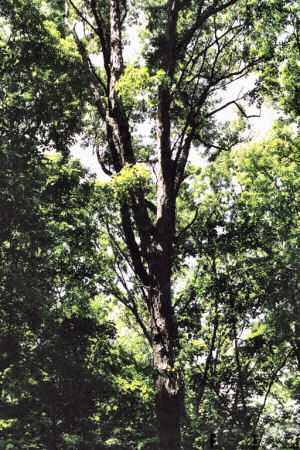
Maryland State Tree: White Oak
© Bill Cook, Michigan State University
One could make the case that the white oak's promotion to state tree began back before the turn of the century when it became apparent that unchecked exploitation of the nation's forests was not sustainable. In particular, heavy timber operations had led to massive soil erosion and destructive flooding.
When the first European settlers arrived in the area now referred to as Maryland, the landscape was mostly blanketed with thick forests. Years of exploitation of the verdant landscape had taken a toll.
In 1876, at the federal level, Congress created a unit within the Department of Agriculture to assess the quality of and the current condition of the forest lands of the United States.
Five years later, the special unit was expanded, becoming the Division of Forestry and in 1891, the Forest Reserve Act authorized creation of "forest reserves" created from land taken from the public domain. These reserves were managed by the Department of the Interior.
In 1898, a man named Gifford Pinchot, a close ally of President Theodore Roosevelt, was placed at the head of the Division of Forestry.
Two years later, Fred W. Besley, in search of a career in the dairy business at the United States Department of Agriculture (USDA), met Gifford Pinchot.
?Pinchot was so boiling over with enthusiasm about forestry,? Besley later remembered, that then and there I adopted forestry as my career.?
(Bailey & Zubrun, "Fred Besley: The Pioneer of Forestry in Maryland (1872?1960)", 2006)
Besely served as Pinchot's student assistant until January of 1903. He then went on to study forestry at the newly created Yale School of Forestry from which he graduated with honors eighteen months later.
Over the next fifteen years the Division of Forestry expanded further finally becoming the U.S. Forest Service within the Department of Agriculture in 1905. As Chief Forester, Gifford Pinchot, on his way to becoming the "Father of American Forestry," set out to restructure and professionalize the Forest Service.
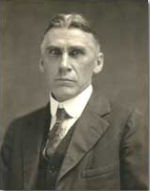
Fred Wilson Besley
Maryland's First State Forester
In 1906, the Maryland legislature created the State Board of Forestry " to protect and manage the newly-established state forests and parks, as well as assist private landowners in managing their timber resources." [1]
The Maryland Board of Forestry consulted Gifford Pinchot for staffing recommendations and Pinchot endorsed Fred W. Besley who was subsequently made Maryland's first state forester.
Besley served as Maryland State Forester for thirty-six years, establishing Maryland's progressive forestry management and conservation systems and making Maryland a leader in forest conservation. He enforced the country's first "Roadside Tree Law" encouraging planting and maintenance of roadside trees and serving as a model to other states. Under his supervision, Maryland's public park and forest lands increased from 1,917 acres to over 117,000 acres.
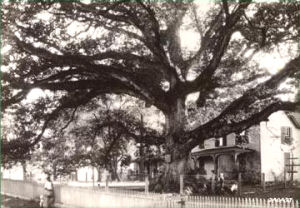
Maryland State Tree: White Oak
Wye Oak, Wye Mills, Maryland
In 1909 Besley encountered a large white oak at Wye Mills, in Talbot County. It was reputed to be the largest white oak in State of Maryland, perhaps in the whole of the United States. The tree was photographed and measurements were logged. The circumference of the tree measured 27 feet, eight inches at a point five feet above the ground. It was recorded as 95 feet tall with branches spreading 185 feet. It was estimated to be some 400 years old.
Ten years later the Wye Oak, as it came to be known, was featured in American Forestry Magazine as the first tree in the American Forestry Association's "Tree Hall of Fame." It was certified as the largest white oak in the country.
In 1925, Fred W. Besley, inspired by the Wye Oak, created the first Champion Tree Program.
In 1939, the State of Maryland purchased the Wye Oak from its last private owner, ?in accordance with our desire to preserve places of historical and outstanding interest,? said Governor O?Connor. Soon after this purchase the Legislature declared the Wye Oak to be the living symbol of our State Tree, the white oak.
("The Quiet Giant, The Wye Oak")
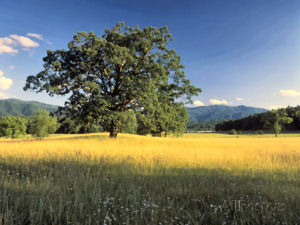
Maryland State Tree: White Oak
ALLPOSTERSURL
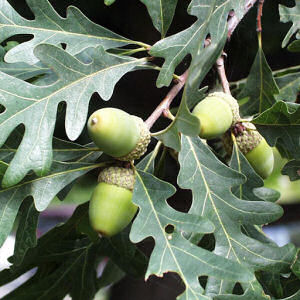
Maryland State Tree: White Oak fruit (acorns)
© Paul Wray, Iowa State University
In 1940, the Wye Oak was named by the American Forestry Association the finest white oak specimen in the country and one of its first National Champion Trees.
It was the Wye Oak that inspired the Maryland Legislature to promote the white oak as Maryland's official state tree.
On May 2, 1941, Governor Herbert O'Conor signed the approved legislation declaring the white oak the state tree of Maryland. The law went into effect on June 1, 1941.
As the Wye Oak had been declared the finest white oak in the country, State Forester F. W. Besley had accumulated around 1,000 seedlings at the state's College Park Nursery. Upon the white oak's adoption as Maryland's official state tree, a number of these seedlings, originally intended for planting on state-owned land, were offered to "responsible" organizations for "State Tree Day" planting on June 1, 1941.
The State has at it College Park nursery approximately 1,000 seedlings grown from acorns of the Wye oak in Talbot county," Besley said, and some of them may be given out to responsible organizations of State Tree Day' planting.
"What's more," Besley said, "we are willing to provide a certificate of parentage guaranteeing that each seedling has the inherent qualities of the famous Wye oak."
("White Oak Will Be State Tree", 1941)
As it was a gift of nature, nature determined the big tree?s course. On June 6, 2002 the mighty Wye Oak succumbed to time and the elements as its massive trunk collapsed during a severe thunderstorm, ending the life of Maryland?s oldest citizen. At its end, the tree measured 31 feet 8 inches in circumference, was 96 feet tall and had an average crown spread of 119 feet. The main bole of the tree weighed over 61,000 pounds.
("The Quiet Giant, The Wye Oak")
Maryland Law
The following information was excerpted from the Code of Maryland, Article State Government, Chapter 7, Section 7?310.
Article State Government
§7?310
The white oak (Quercus alba) is the State tree.
Sources...
Associated Press. "White Oak Will Be State Tree." The Morning Herald [Hagerstown] 15 May 1941: 14. Print.
[1] Bailey, Robert, and Francis Zubrun. Fred Besley: The Pioneer of Forestry in Maryland (1872?1960). Durham: The Forest History Society, Spring 2006. PDF.
Beard, Leslie C. "Urges City Get Seedling." The Daily Mail [Hagerstown] 17 May 1941: 3. Print.
"Code of Maryland § 7-310." General Assembly of Maryland. State of Maryland, n.d. Web. 2 Dec. 2016.
Shearer, Benjamin F. and Barbara S. State Names, Seals, Flags and Symbols: A Historical Guide Third Edition, Revised and Expanded. Westport, Conn: Greenwood Press, 3 Sub edition, 2001.
[2] "The Quiet Giant, The Wye Oak." Maryland Department of Natural Resources. State of Maryland, n.d. Web. 2 Dec. 2016.
"Will Plant Seedling Of Famous Wye Oak." The Evening Sun [Hanover] 27 May 27: 6. Print.
Zumbrun, Champ. "Maryland Celebrates the 90th Anniversary of the First Statewide Big Tree Contest." Maryland Department of Natural Resources. State of Maryland, n.d. Web. 2 Dec. 2016.
Additional Information
Maryland State Tree - White Oak: Maryland Manual On-Line.
The Quiet Giant, The Wye Oak: Maryland Department of Natural Resources.
Quercus alba L. (white oak): United States Department of Agriculture: Forest Service: Agriculture Handbook 654: Silvics of North America.
Quercus alba: University of Connecticut Plant Database of Trees, Shrubs and Vines.
Wye Oak, Maryland: The Native Tree Society (NTS): a cyberspace interest group devoted to the documentation and celebration of trees and forests of the North America and around the world, through art, poetry, music, mythology, science, medicine, wood crafts, and collecting research data for a variety of purposes..
Quercus alba L. (white oak): USDA, NRCS. 2016. The PLANTS Database (http://plants.usda.gov). National Plant Data Center, Baton Rouge, LA 70874-4490 USA.
Quercus alba L.: Integrated Taxonomic Information System (ITIS).
Quercus alba L.: Plants For A Future (PFAF): researching and providing information on ecologically sustainable horticulture.
Quercus alba: Search for images of Quercus alba with Google.
Maryland's Big Tree Program :
A tribute to champions from the Maryland Department of Natural Resources.
:
A tribute to champions from the Maryland Department of Natural Resources.
State trees: Complete list of official state trees from NETSTATE.COM.
More symbols & emblems: Complete list of official Maryland state symbols from NETSTATE.COM.
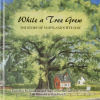
While a Tree Grew
Elaine Rice Bachmann
While a Tree Grew: The Story of Maryland's Wye Oak, Elaine Rice Bachmann. 25 pages. Publisher: Tidewater Publishers (September 1, 2006) Reading level: Grades Preschool - grade 2.
While a Tree Grew takes young readers on a journey through time with Maryland's most famous tree, the great Wye Oak, by tracing the tree's history from when it was a seedling to its fall during a storm in 2002. While a Tree Grew gives a new generation a glimpse into this venerable Maryland icon and the 460 years of history that surrounded it.
Preschool to grade 2.
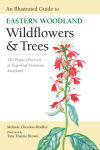
An Illustrated Guide to
Eastern Woodland
Wildflowers and Trees
Melanie Choukas-Bradley
An Illustrated Guide to Eastern Woodland Wildflowers and Trees: 350 Plants Observed at Sugarloaf Mountain, Maryland, by Melanie Choukas-Bradley. 480 pages. Publisher: University of Virginia Press (February 5, 2008)
This volume is an exquisitely illustrated guide to 350 eastern woodland wildflowers and trees found on site at Sugarloaf Mountain, Maryland. Many of these plants also thrive across a wide region of the eastern United States and Canada, making this guide a remarkably helpful resource for both mid-Atlantic naturalists?amateur and experienced?and botanical enthusiasts across North America.
An Illustrated Guide to Eastern Woodland Wildflowers and Trees includes a user-friendly key, an illustrated glossary of frequently used botanical terms, and is packed with nearly 400 elaborately and artistically detailed pen-and-ink drawings to make plant identification simple and fun.
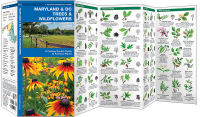
Maryland & DC
Trees & Wildflowers
James Kavanagh
Maryland & DC Trees & Wildflowers, by James Kavanagh. Folding pamphlet. Publisher: Waterford Press; First edition (October 1, 2016)
Maryland's state flower - the black-eyed Susan - is one of thousands of species of plants growing in the diverse ecosystems found throughout the region. This beautifully illustrated guide highlights over 140 familiar and unique species of trees, shrubs and wildflowers. It also includes an ecoregion map featuring prominent botanical sanctuaries that any nature enthusiast would love to explore. Laminated for durability, this lightweight, pocket-sized folding guide is an excellent source of portable information and ideal for field use by visitors and residents alike.
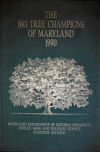
The Big Tree
Champions of Maryland 1990
The Big Tree Champions of Maryland 1990, by the Maryland Department of Natural Resources Forest, Park and Wildlife Service: Forestry Division. 119 pages. Publisher: Maryland Department of Natural Resources. (1990)
This is a comprehensive tree guide with circumference, height and spread statistics of many trees. Full of info and full of black and white photos.
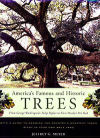
America's Famous
and Historic Trees
Jeffrey G. Meyer
America's Famous and Historic Trees: From George Washington's Tulip Poplar to Elvis Presley's Pin Oak
by Jeffrey G. Meyer. 130 pages. Houghton Mifflin Harcourt; First Edition (April 20, 2001)
America's Famous and Historic Trees tells the stories of various trees that Meyer and his cohorts rescued or propagated: oftentimes, when trees were going to be cut down, he and his workers headed off the bulldozers, rescuing the tree with their massive tree hoe. Other trees--like the Indian Marker Pecan in southeast Dallas--were propagated before they died.
Trees : National Champions
by Barbara Bosworth. 144 pages. The MIT Press; First Edition (August 19, 2005)
Bosworth captures the ineffable grace and dignity of trees with clarity and directness: the green ash that shades a Midwestern crossroads, the common pear that blooms in a Washington field, and the Florida strangler fig with its mass of entwining aerial roots. Her black and white photographs, panoramic views taken with an 8 x 10 camera, show the immensity of the largest species and the hidden triumphs of the smallest
Plants, Seeds & Flowers: Bulbs, seeds, plants, fertilizer, plant containers and more.
Gardening Tools: Pruners, rakes, shovels, hoes, trowels, cultivators and tillers, greenhouses, yard carts and more.

